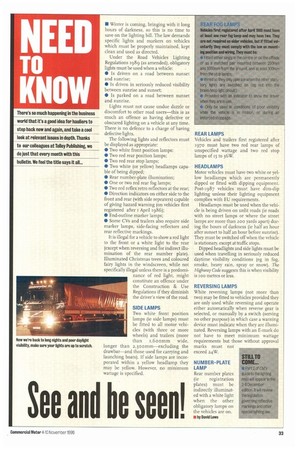See and be seen! NEE
Page 35

If you've noticed an error in this article please click here to report it so we can fix it.
TO
KNOW
There's so much happening in the business world that It's a good idea for hauliers to step back now and again, and take a cool look at relevant issues in depth. Thanks to our colleagues at Tolley Publishing, we do just that every month with this bulletin. We feel the title says it all... • Winter is coming, bringing with it long hours of darkness, so this is no time to save on the lighting bill. The law demands specific lights and markers on vehicles which must be properly maintained, kept clean and used as directed.
Under the Road Vehicles Lighting Regulations 1989 (as amended), obligatory lights must be used when a vehicle: • Is driven on a road between sunset and sunrise; • Is driven in seriously reduced visibility between sunrise and sunset; • Is parked on a road between sunset and sunrise.
Lights must not cause undue dazzle or discomfort to other road users—this is as much an offence as having defective or obscured lighting on a vehicle at any time There is no defence to a charge of having defective lights.
The following lights and reflectors must be displayed as appropriate: • Two white front position lamps; • Two red rear position lamps; • Two red rear stop lamps; • Two white (or yellow) headlamps capable of being dipped; • Rear number-plate illumination; • One or two red rear fog lamps; • Two red reflex retro reflectors at the rear; • Direction indicators on either side to the front and rear (with side repeaters) capable of giving hazard warning (on vehicles first registered after I April 1986); • End-outline marker lamps; • Some CVs and trailers also require side marker lamps, side-facing reflectors and rear reflective markings.
It is illegal for a vehicle to show a red light to the front or a white light to the rear (except when reversing and for indirect illumination of the rear number plate). Illuminated Christmas trees and coloured fairy lights in the windscreen, while not specifically illegal unless there is a predominance of red light, might constitute an offence under the Construction 8r. Use Regulations if they diminish the driver's view of the road.
SIDE LAMPS Two white front position lamps (ie side lamps) must be fitted to all motor vehicles (with three or more wheels) and trailers (more than 1,600mm wide, longer than 2,300MM—excluding the drawbar—and those used for carrying and launching boats). If side lamps are incorporated within a yellow headlamp they may be yellow. However, no minimum wattage is specified. REAR LAMPS Vehicles and trailers first registered after 1970 must have two red rear lamps of unspecified wattage and two red stop lamps of 15 to 36W.
HEADLAMPS Motor vehicles must have two white or yellow headlamps which are permanently dipped or fitted with dipping equipment. Post-1987 vehicles must have dim-dip lighting unless their lighting equipment complies with EU requirements.
Headlamps must be used when the vehicle is being driven on unlit roads (ie roads with no street lamps or where the street lamps are more than 200 yards apart) during the hours of darkness (ie half an hour after sunset to half an hour before sunrise). They must be switched off when the vehicle is stationary, except at traffic stops.
Dipped headlights and side lights must be used when travelling in seriously reduced daytime visibility conditions (eg in fog, smoke, heavy rain, spray or snow). The Highway Code suggests this is when visibility is too metres or less.
REVERSING LAMPS White reversing lamps (not more than two) may be fitted to vehicles provided they are only used while reversing and operate either automatically when reverse gear is selected, or manually by a switch (serving no other purpose) in which case a warning device must indicate when they are illuminated. Reversing lamps with an E-mark do not have to meet minimum wattage requirements but those without approval marks must not exceed 24W.
NUMBER-PLATE LAMP Rear number plates (ie registration plates) must be indirectly illuminated with a white light when the other obligatory lamps on the vehicles are on. REAP Pnr."
Vehicles first registered after April 1980 must have at least one rear fog lamp and may have two. They are not required on older vehicles, but if fitted voluntarily they must comply with the law on mounting position and wiring. They must be:
* Fitted either singly in the centre or on the offside or as a matched pair mounted between 250mm anci 1000mm from the ground, and at least 100mm from the stop lamps; *Wired so they only operate when the other statutory lights are switched on (eg not into the brake/stop light circuit): is Provided with an indicator to show the driver when they are in use.
• Only be used in conditions of poor visibility while the vehicle is in motion, or durin an enforced stoppage.








































































































































